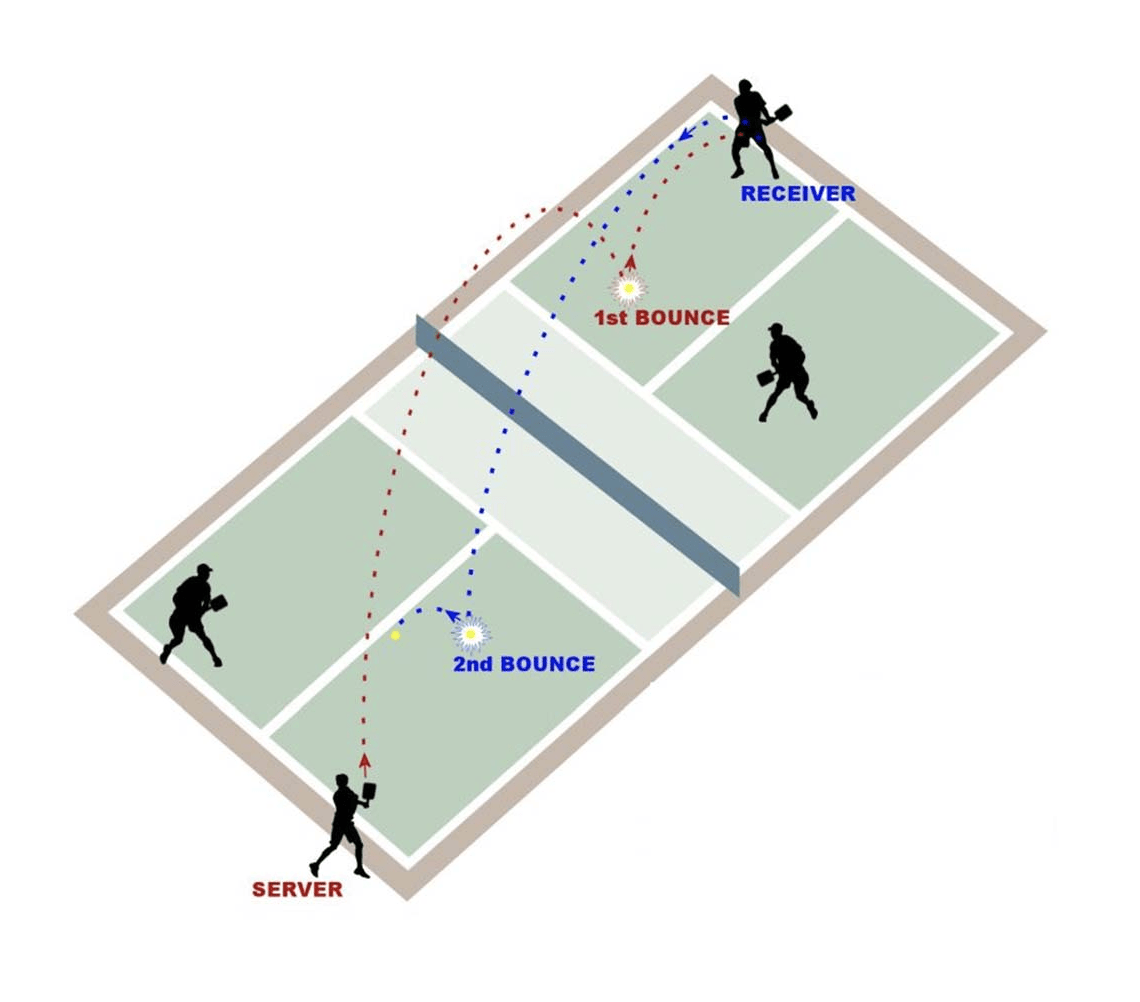Greetings Pickleball Enthusiasts,
Welcome to this month's edition of our Pickleball Newsletter! This time, we're diving into the dynamic world of a typical 4-person pickleball game– a thrilling game of strategy and teamwork we all love. Whether you're a seasoned player or a newbie eager to learn, this newsletter will break down the rules and strategies to ensure you make the most out of your next 4-person pickleball match.
Rule #1: Teams and Positioning
In a 4-person pickleball game, you'll have two teams of two players each, here we will label them as Team A and Team B. The players on each team must position themselves on opposite sides of the court, with one player from each team on each side. Effective communication and coordination with your teammate are key to a winning game.
Rule #2: Serving Rotation
The serving rotation is critical in 4-person pickleball. Team A's player 1 serves to Team B's player 1, and the rally begins. After the first point concludes, if a point is scored by the serving team, the serving team switches places, with player 1 moving to the opposite side. This rotation continues throughout the game, ensuring everyone has an opportunity to serve and defend on both sides of the court.
Rule #3: Scoring System
The scoring system in 4-person pickleball, points are earned only by the serving team, and a point is scored when the opposing team faults. Games are typically played to 11 points, and a two-point margin is required for victory. Rotate, strategize, and focus on precision to secure those crucial points.
Rule #4: Double Bounce Rule
In 4-person pickleball, the serving team must let the return from the opposing team bounce once before attempting to return it. Likewise, the receiving team must also allow the serving team's serve to bounce once before hitting it back. This rule ensures fair play and engaging rallies.
Rule #5: Kitchen Rules
Pickleball players are not allowed to enter the kitchen, also known as the non-volley zone, unless the ball bounces in this area first. This rule applies to both serving and receiving teams, emphasizing the importance of strategic placement and shot selection.
Serving Rules:
In pickleball, a legal serve is essential for starting a point. To ensure fair play and maintain the integrity of the game, here are the key rules for a legal serve:
-
Underhand Serve: The serve must be executed underhand. The paddle must be below the server's wrist when contacting the ball. Any attempt to serve overhand is considered a fault.
-
Contact Below Waist Level: The ball must be struck below the server's waist level at the time of contact. This ensures that the serve is performed in an underhand motion, contributing to the game's emphasis on strategy and skill rather than power.
-
Serve Diagonally: The server must stand behind the baseline and serve the ball diagonally across the net. The serve must land in the diagonally opposite service court (cross-court). The ball must clear the non-volley zone (the kitchen) and bounce once within the court lines on the opponent's side.
-
No Volleying on the Serve: The server and the receiver cannot volley (hit the ball in the air without it bouncing) until after the ball has bounced once on each side. This means that both the server and the receiver must let the ball bounce before hitting it.
-
Foot Faults: The server must keep both feet behind the baseline and may not step on or over the baseline until after the ball is struck. A foot fault results in a fault, and the serve is replayed.
-
Faults and Let Serves: If the server commits any fault (e.g., serving out of bounds, hitting the net, or violating other rules), it results in a fault, and the serve is lost. However, if the ball hits the net and lands in the correct service court, it is considered a let serve.
-
Server's Score: The server says the score at the beginning of each serve and the serve must occur within 10 seconds of saying the score. For example, if the serving team, Team A, has a score of 3 and the receiving team has a score of 4 and the server is the first server for that team, the server would announce "3, 4, 1"- 3 points for the serving team, Team A, 4 points for the opposing team, Team B, and the last 1 is indicating that player is the first server for the team during that round. If they lose the point the other player on the same team, Team A, would serve and say, "3, 4, 2". The last "2" indicate that they are the second server. If that point is also lost the serve goes to the opposing team. Where the first server would announce, "4, 3, 1" and so on until the score reaches 11 points and wins by at least 2 points.
Adhering to these serve rules ensures a fair and enjoyable pickleball game. Keep in mind that local variations or house rules may exist, so it's always a good idea to confirm specific rules before playing in a new location or with different players.
Strategy Tips:
-
Communication is Key: Keep the lines of communication open with your teammate. Share your intentions, call out shots, and coordinate movements to maximize efficiency on the court.
-
Positional Awareness: Pay attention to your position on the court and that of your opponents. Strategic movement and anticipation can make the difference between winning and losing points.
-
Varied Shots: Mix up your shots with dinks, volleys, and lobs to keep your opponents on their toes. A diverse range of shots will make it challenging for the opposing team to predict your next move.
-
Teamwork: Work together with your teammate to cover the court effectively. Knowing when to take the lead and when to provide support is crucial for success in 4-person pickleball.
Embrace the excitement of 4-person pickleball, and may your next match be filled with thrilling rallies and victorious moments. Until next time, keep swinging those paddles and enjoying the wonderful world of pickleball!
Best regards,
4JoyPaddles
We Play 4 Joy!

